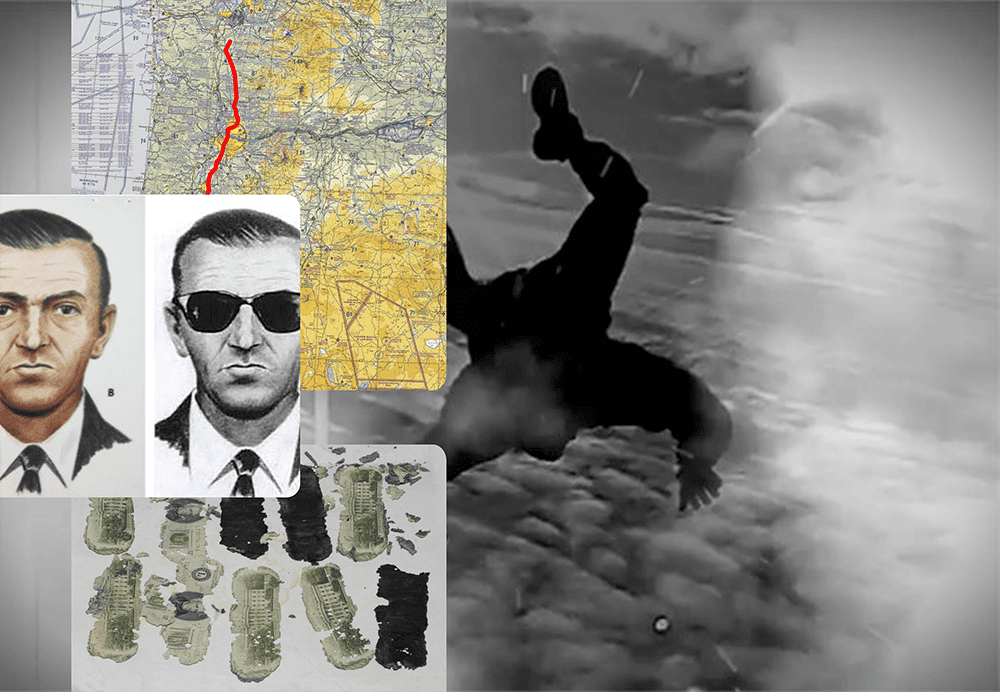EXTRA INFORMATION
This crime remains unsolved to this day, the hijacker has never identified. The FBI who lead the investigation interviewed hundreds of people, tracked leads across the nation, and scoured the aircraft for evidence. An extensive search and recovery operation uncovered no significant material evidence related to the hijacking. In terms of physical evidence collected on the airplane, the FBI recovered 66 unidentified fingerprints, Cooper’s tie and his cigarette butts. Years later when DNA analysis was possible, no match could be made. Detailed composite sketches were made using several separate but matching physical descriptions of the hijacker. By the 5-year anniversary of the hijacking, the FBI had considered more than 800 suspects and eliminated all but 24 from consideration. The police undertook large scale land, air and water searches of the flight path. They arranged an intricate experimental recreation of the drop, used precise mathematical predictions and even used Air Force blackbird planes and submarines in their searches. Then in 1980, a young boy found three rotting packages full of twenty-dollar bills along the banks of the Columbia River. The bills matched the ransom money serial numbers – this was the only cash ever recovered. The main problem with the investigation was that a precise search area was difficult to define, as even a small difference in estimates of the aircrafts speed, or the environmental conditions along the flight path, changed Cooper’s projected landing point. An important variable was the length of time Cooper remained in free fall before pulling his ripcord. The investigation into this air-jacking continued for 45 years and was finally suspended from active investigation in 2016 after accumulating 66 case files of research. One big outcome of this crime (and several other imitations that followed in the year after) was that it led to immediate and major changes for commercial aviation and stricter airport security measures. Metal detectors were installed, baggage inspection became mandatory, and passengers who paid cash for tickets on the day of departure were selected for additional scrutiny. What do you think about this case? Were all stones turned? How about the consequences of the crime, did this need to happen in order for adequate safety measures to be brought in?⚠️ New Questions
- What do you think about this investigation? Was it thorough?
- Should old/cold cases continue to be investigated years after the crime took place?
- Do we have to have bad things happen in order to put safety procedures in place?
🔎 Summary
On the 24th of November, 1971, a nondescript man calling himself Dan Cooper used cash to buy a one-way ticket from Portland, Oregon to Seattle, Washington. This man boarded the flight and then shortly after take-off, called a flight attendant over to deliver a note. The message read: “Miss—I have a bomb in my briefcase and want you to sit by me.”
The flight attendant obliged and sat with the man. She asked to see the bomb and Cooper opened his briefcase. The flight attendant saw what she assumed was dynamite attached with wire and a large battery. Cooper closed the briefcase and told the flight attendant his demands. The flight attendant took note and relayed the demands to the cockpit, informing the flight crew of the situation. The pilot contacted the flight operations headquarters and relayed the hijacker’s demands: “[Cooper] requests $200,000 in a knapsack by 5:00pm. He wants two front parachutes and two back parachutes. He wants the money in American currency.” Cooper began making additional demands and arranged that upon the flight landing at its destination, the 36 passengers aboard were to be exchanged for the money, parachutes and the plane was to be refueled for another journey. When his demands were met, Cooper gave the cockpit crew new flight instructions: a course was to be made toward Mexico City at the minimum airspeed possible and a 10,000-foot altitude. Cooper also specified that the landing gear must remain deployed and that the cabin must remain unpressurised. Approximately thirty minutes after taking off for a second time, the hijacker opened the aircraft’s door, deployed the staircase, and parachuted into the night somewhere over southwestern Washington. The plane landed safely, but Cooper was never found. An extensive investigation was launched the moment the ransom was called in, to find this so-called Dan Cooper and retrieve the extorted cash. But where do you start investigating this crime? What evidence could you collect and use to identify this unknown man? Better yet, how could this have been prevented in the first place? At this time in 1970s, over 130 air-jackings like this occurred within 4 years in the US alone. Sometimes there was more than one hijacking on the same day. Something had to be done to stop this.
🔎 Evidence

📝 The Transcript
Show full transcript
Video and image montage of air-jacking story with narration by voice-over
On the 24th of November, 1971, a nondescript man calling himself Dan Cooper used cash to buy a one-way ticket from Portland, Oregon to Seattle, Washington. This man boarded the flight and then shortly after take-off, called a flight attendant over to deliver a note. The message read: “Miss—I have a bomb in my briefcase and want you to sit by me.” The flight attendant obliged and sat with the man. She asked to see the bomb and Cooper opened his briefcase. The flight attendant saw what she assumed was dynamite attached with wire and a large battery. Cooper closed the briefcase and told the flight attendant his demands. The flight attendant took note and relayed the demands to the cockpit, informing the flight crew of the situation. The pilot contacted the flight operations headquarters and relayed the hijacker’s demands: “[Cooper] requests $200,000 in a knapsack by 5:00pm. He wants two front parachutes and two back parachutes. He wants the money in American currency.” Cooper began making additional demands and arranged that upon the flight landing at its destination, the 36 passengers aboard were to be exchanged for the money, parachutes and the plane was to be refueled for another journey. When his demands were met, Cooper gave the cockpit crew new flight instructions: a course was to be made toward Mexico City at the minimum airspeed possible and a 10,000-foot altitude. Cooper also specified that the landing gear must remain deployed and that the cabin must remain unpressurised. Approximately thirty minutes after taking off for a second time, the hijacker opened the aircraft’s aft door, deployed the staircase, and parachuted into the night somewhere over southwestern Washington. The plane landed safely, but Cooper was never found.Presenter in theatre talking to camera; parachute model drops into frame
An extensive investigation was launched the moment the ransom was called in, to find this so-called Dan Cooper and retrieve the extorted cash. But where do you start investigating this crime? What evidence could you collect and use to identify this unknown man? Better yet, how could this have been prevented in the first place? At this time in 1970s, over 130 air-jackings like this occurred within 4 years in the US alone. Sometimes there was more than one hijacking on the same day. Something had to be done to stop this.Presenter in theatre talking to camera – passport & ticket, briefcase w/ dynamite
This crime remains unsolved to this day, the hijacker has never identified. The FBI who lead the investigation interviewed hundreds of people, tracked leads across the nation, and scoured the aircraft for evidence. An extensive search and recovery operation uncovered no significant material evidence related to the hijacking. In terms of physical evidence collected on the airplane, the FBI recovered 66 unidentified fingerprints, Cooper’s tie and his cigarette butts. Years later when DNA analysis was possible, no match could be made. Detailed composite sketches were made using several separate but matching physical descriptions of the hijacker. By the 5-year anniversary of the hijacking, the FBI had considered more than 800 suspects and eliminated all but 24 from consideration. The police undertook large scale land, air and water searches of the flight path. They arranged an intricate experimental recreation of the drop, used precise mathematical predictions and even used Air Force blackbird planes and submarines in their searches. Then in 1980, a young boy found three rotting packages full of twenty-dollar bills along the banks of the Columbia River. The bills matched the ransom money serial numbers – this was the only cash ever recovered. The main problem with the investigation was that a precise search area was difficult to define, as even a small difference in estimates of the aircraft’s speed, or the environmental conditions along the flight path, changed Cooper’s projected landing point. An important variable was the length of time Cooper remained in free fall before pulling his ripcord. The investigation into this air-jacking continued for 45 years and was finally suspended from active investigation in 2016 after accumulating 66 case files of research. One big outcome of this crime (and several other imitations that followed in the year after) was that it led to immediate and major changes for commercial aviation and stricter airport security measures. Metal detectors were installed, baggage inspection became mandatory, and passengers who paid cash for tickets on the day of departure were selected for additional scrutiny.
- What do you think about this case?
- Were all stones turned?
- How about the consequences of the crime, did this need to happen in order for adequate safety measures to be brought in?

🧠 Thought exercise
- What would you do to investigate this crime? Where would you start?
- How could this have been prevented? Do you think Cooper could pull this off today? If it happened today would he be caught?
- How immoral was this crime? Who was the victim? Do they deserve justice?
Where should I be?

